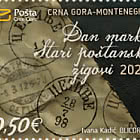Jaz Beach
Jaz Beach is located in the cove of the same name, to the west of the town of Budva. It is enclosed by Cape Mogren on the east and by Cape Jaz on the west. It has two sections, one of which is 800 metres long and the other 400 metres long.As a site where major concerts featuring worldwide and local music stars have been held, it has developed a unique reputation on a global scale. In 2015, the world’s leading travel guide, Lonely Planet, declared Jaz the best European beach. This beach has won “Blue Flags” for many years and is designated as a third-category natural monument.Montenegro Post is issuing a commemorative postage stamp and a first-day cover as part of the Tourism – Beaches - Jaz Beach edition.
Mogren Beach
Mogren Beach is one of the most well-known beaches on the Budva Riviera. It is comprised of two smaller beaches called Mogren I and Mogren II, that are connected by a short tunnel cut through the natural rock.According to tradition, it was named after the sailor Mogrini, who, as the sole survivor of a shipwreck, found rescue on it, on the day of St. Anton, in whose honour he erected and consecrated a church as a sign of gratitude.Mogren Beach is now protected as a third-category natural monument, and to the south-west, above the beach, there is also Mogren Fortress, built in the middle of the 19th century.Montenegro Post is issuing a commemorative postage stamp and first-day cover as part of the Tourism - Beaches - Mogren Beach edition.
Bečići Beach
Bečići Beach won the Grand Prix in Paris in 1935 and was chosen as the most beautiful beach in Europe; thirty years later it was awarded the “Golden Palm” as the most beautiful beach on the Mediterranean.It is approximately 2,000 metres long. It is especially notable for its multi-coloured sand, which is formed by the erosion of rock from four streams that flow into the sea there.The Church of St. Thomas, located on an elevation in the centre of the beach towards the mainland, is surrounded by cypress trees and is thought to have been built in the 15th century by the last Paštrovići duke, St. Stefan Štiljanović.Montenegro Post is issuing a commemorative postage stamp and a first- day cover as part of the Tourism - Beaches - Bečići Beach edition.














































